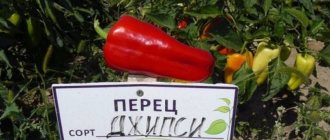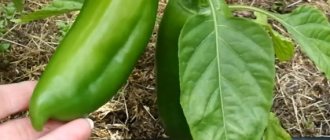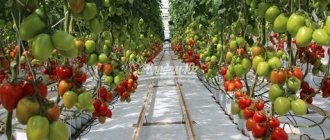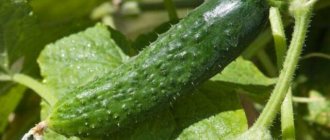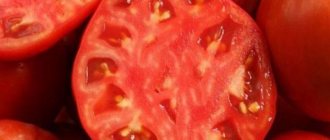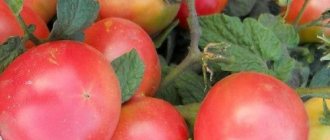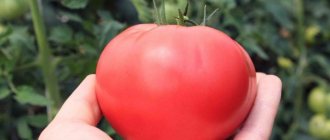Everyone has sweet peppers on their table. This crop is useful, it can be grown throughout the country, there are many varieties - everyone can choose the best one for themselves. In order not to make many mistakes during cultivation, while gaining experience, you need to know more theory in advance. When you understand what seeds to buy and how to cultivate this vegetable later, the risks are minimal. Today we will present you with an excellent option for your garden - Gladiator pepper. The description of the variety and characteristics will show the pros and cons, the section on cultivation will show the cultivation technology. The reviews and photos of summer residents are pleasantly surprising.
Yellow varieties of pepper are considered healthier - they contain more vitamins and do not cause an allergic reaction. Suitable for feeding children, allergy sufferers, and pregnant women.
general information
“Gladiator” has a great name, all because its characteristics are really decent. Summer residents have already appreciated this variety and praise it. Pepper was bred in Holland, and breeders instilled in it the best qualities. The result has already been tested in all corners of our country and beyond. It can be grown both outdoors and in a greenhouse. Yields are high in both cases. It can be planted even in the north in closed ground. You will like the variety, besides, it is easy to grow and the hassle is minimal.
Reviews from those who planted
“I have been planting this pepper for several years now. I liked the abundant fruiting and the size of the fruits. Even my neighbor liked the shade of this vegetable. It grows well inside my greenhouse and other varieties get along well with it. The main thing is to water it, sometimes feed it with organic fertilizer, and you can expect a good harvest.”
“I choose varieties according to their descriptions. In fact, you can grow good fruit. They are very tasty. The thick and dense pulp has a lot of juice and sweetness. I needed peppers for planting under film. This variety was just right.”
“I’ve only been gardening for a few years, but I’ve already been able to achieve success. They were especially evident in Gladiator. I didn’t even think that I would be able to get such a good harvest. Indeed, the pepper has grown so large and juicy. The bright yellow fruits glowed like lanterns on their bushes.”
The choice of many landowners fell on the Gladiator pepper variety because of the excellent quality of its fruits. They have a good presentation and can be used not only for home use, but also for sale. It's worth growing this vegetable! This is a very profitable idea!
Gladiator pepper is mid-season, distinguished by large, weighty, thick-walled fruits. Their weight reaches 350 grams. The plant begins to bear fruit 115-130 days after germination. This pepper takes root well in open ground and in greenhouses.
The plant does not grow tall, only 45-50 cm in height, but will form spreading, with dense greenery. The fruits are elongated, cone-shaped, and have a glossy and ribbed surface structure. At technical maturity, peppers are light green in color, while at biological maturity they are bright yellow.
Gardeners love Gladiator for its taste: the fruit pulp is tender, juicy, with a pleasant aroma. Seeds for seedlings should be sown at the end of February. Picking is done after two true leaves appear. The variety does not like transplanting, so it is better to pick in peat pots so as not to disturb the root when planting plants in the ground. Planting pattern 40x60 cm.
It is worth choosing a place for planting that is warm, sunny, protected from the winds. The optimal concentration of pepper bushes is 4-5 plants per square meter. meter of area. Peppers are not planted too deep into the ground, and this makes no sense, since peppers, unlike tomatoes, do not have strong shoots from below.
Further care will consist of timely watering and fertilizing. Plants need to be fed 3 times during the entire growth period, during the period of plant transplantation and during fruit set.
Pepper does not like chlorine very much, so chlorine-containing fertilizers should be avoided!
Pepper Gladiator agro attracts attention with its large giant fruits with a golden-sunny color. The highlight is the thick, meaty, flavorful wall (peppers are especially good in salads). The variety is well adapted and suitable for cultivation under film and in open soil.
Characteristics and description
Bushes
The Gladiator pepper variety cannot be called short, but it is not tall either. The bushes reach up to 55 cm, but they look very impressive, as they spread strongly to the sides. In order for plants to grow and develop well, it is better not to plant more than 4-5 seedlings per square meter. The leaves have a rich green tint, the bushes are well leafy. The fruits grow downward and adhere well to the branches. The bushes are not affected by diseases.
Preparing for winter
You should not leave fruits on the bushes during frosts. You need to collect them in advance and place them in special boxes, boxes or other containers. It is better to stack them in sorted form.
Storage rules
To maintain the value of a product, it must be stored correctly. Pepper can be stored perfectly in boxes or paper bags. Having laid out the sorted fruits in containers, you need to leave them in a dark, cool place such as a basement or cellar.
Resistance to diseases and pests
Reviews from summer residents indicate that Gladiator sweet peppers do not get sick. That is, it is highly stable. But at the same time, an experienced gardener will always carry out competent pre-sowing treatment. As for insects, crops that have medium ripening periods may be at risk. Peppers are not always, but can still be harmed by aphids, thrips, whiteflies, slugs, caterpillars, and beetles. All control measures must be carried out in a timely manner, taking into account the fact that during flowering and fruiting only environmentally friendly preparations or traditional methods are used.
Features of growing and caring for the variety
First, seedlings are prepared. The seeds need to be sown to a depth of 3 cm. They begin to germinate at a temperature of about 27 C. When real leaves begin to appear on the plant, it must be transplanted into a separate cup. Its capacity should be 0.5 liters.
Since this pepper does not like being transplanted, after this procedure it takes a long time to come to its senses. A special drug can help restore his strength during this period. Timely watering, fertilizing and loosening of the soil are carried out.
This variety is mainly grown in regions with warm climates because the pepper loves a lot of sun.
Advantages and disadvantages
This variety can be called one of the best; it is difficult to find any disadvantages, which you could already understand from the description of the variety, photos, and reviews of the Gladiator pepper. Main advantages:
May be interesting The best varieties of cucumbers for the Moscow regionCucumber Siberian Garland: description and characteristics, reviewsAdvantages and disadvantages of the cucumber hybrid “Merchant f1”
- high-yielding pepper – up to 12 kg;
- versatility of cultivation and use in the kitchen;
- disease resistance;
- rich vitamin composition, excellent taste and aroma;
- long storage and the possibility of growing for sale.
Flaws:
- possible insect attacks;
- sensitivity to low temperatures and lack of light.
If you liked this variety and want to plant it in the new season, then read the next section about agricultural technology. This knowledge will help you grow an excellent harvest without possible troubles.
Planting time for seedlings
You can start doing this in May. If the climatic conditions in your region are too harsh, you will have to use a covering material, a film. About six sprouts can fit on one square meter. Peppers are planted in the soil without making any special holes, since they do not have lateral roots.
Productivity. On one square meter you can get about six kilograms of crop.
Attention! When planting peppers in open ground, it is necessary to use film at night. If the plant is planted in a greenhouse, periodic ventilation should be done, especially when buds and fruits form!
Agrotechnics of cultivation
We sow seedlings
The variety of sweet pepper “Gladiator” begins to be sown from February to mid-March. If the climate in the region is mild or you have a greenhouse and lamps, then you can sow early. If not, then it is better to postpone the moment until spring. But it is still better to purchase additional lighting, since even in March and April there are often many cloudy days. Pepper needs at least 10-12 hours of light.
Sowing is carried out after pre-treatment and selection of seeds. First, you need to discard empty seeds by soaking them in salt water - 1 spoon of salt per 1 liter of water. Then soak in potassium permanganate for 30-40 minutes, if there was no information about processing on the packaging. Next, the seed must be washed with warm water and dried on a radiator. The soil is prepared using soil from the garden, humus, sand and mineral fertilizer. The first two components are taken equally, sand is half as much, feeding according to the instructions. The soil is poured with boiling water and dried.
Peppers are usually planted directly into cups that can be transferred to the ground. This helps not to injure the very delicate root system. The seeds are buried 1 cm, moistened, and covered with film. The temperature for germination should be 26-29 degrees. When the seedlings have sprouted, the film needs to be removed, trays placed on the window and lighting nearby. Watering is carried out as it dries; feeding with “Kornevin” or “Epin” can be done at about the age of 10-14 days.
Water for irrigation should be taken at room temperature and that which has stood for a day. Fertilizing can be applied by spraying.
Transfer to the street
In May, when all the frosts have passed, the seedlings are planted in a permanent place. The area is dug up, humus or compost is added, and plant debris is removed. You will also need to pour boiling water over the area under the seedlings to protect them from insects and diseases. Mineral fertilizer rich in nitrogen and phosphorus is poured into the hole, watered with warm water and seedlings are planted. Before this, it is hardened for two weeks. No more than 4 plants are placed per square meter.
Pepper does not like wind or drafts. Keep this in mind when choosing a location on the site. There should also be no swampy areas.
Care after landing
Caring for the Gladiator pepper variety is quite simple. Yield crops always require a lot of moisture and fertilizing. To maintain optimal moisture, bushes can be mulched with straw or sawdust. For the first week after planting, it is better to cover the seedlings at night; they do not need fertilizer. Mineral fertilizer is applied for the first time after two weeks; pepper needs a lot of phosphorus and potassium at this moment. Further feeding is applied every 14-20 days, alternating organic and mineral preparations. If you use droppings as fertilizer, then it is combined with watering. Additionally, you can use yeast supplements; this folk recipe is very effective (a bag of bulk product per bucket of water).
To further protect the bushes, they are sprayed with a manganese solution once a week, and ash is scattered throughout the garden. Of course, there should be no weeds on the site. If insects begin to bother you, they are driven away with folk infusions - tansy, wormwood, marigold, calendula, onion skins or garlic. To make it less difficult for the bushes, you can place supports in the form of sticks nearby.
How to grow Gladiator peppers correctly, recommendations and tips
It is necessary to first prepare special containers for subsequent seedlings. After this, you should plant the plant seeds in these containers. First you need to prepare the seeds for further planting. Professionals in this matter advise adhering to the following instructions:
- First of all, the seeds must be immersed in an aquatic environment. It is best to allocate a separate container for this, which will allow you to determine the quality of the seeds used for planting. Those that float are unusable and empty.
- Next, you need to soak the seeds in water for 2 days. In order to increase the rate of seed growth, you can add a growth stimulant to the water.
- Treat the selected seeds with a weak solution of potassium permanganate, then wash them in warm water.
Such manipulations will not only speed up the growth time of your seeds, but also increase their immunity to various pathogenic bacteria that often parasitize the leaves and fruits of vegetable crops.
When you begin to prepare the soil for planting seeds, you need to make a depression of no more than 1.5 cm, as this is enough for the successful development of your pepper. Regarding the temperature regime, it is extremely important to maintain a range from 23 to 28 degrees Celsius, since this is the interval that is most favorable for the successful growth of Gladiator.
Growing peppers in the ground
When the Gladiator pepper seedlings reach 65 days of age, they are transplanted into the ground. Experts recommend transshipment rather than picking plants. The seedlings are transplanted along with the soil in which they grew so that the roots are not damaged. It is recommended to pour boiling water over the prepared holes. Such soil heating will increase the survival rate of plants.
The optimal transplant period is May. When moving plants into open ground, they are guided by the soil temperature and the absence of the likelihood of frost. When transplanting into greenhouses, you need to look at the established daylight hours.
When grown in open ground, it is recommended to cover young seedlings overnight with film or non-woven covering material. This will prevent the plants from becoming overcooled.
The optimal planting pattern for a semi-spreading bush is 40x60 cm. There should be no more than 6 plants per square meter. They are fertilized 10 days after transplantation. It is recommended to use slurry diluted with water or diluted bird droppings. At the same time, phosphorus-potassium fertilizers and wood ash are added.
During the period of fruit formation, the need for fertilizing increases. At this time, experts recommend adding a solution of bird droppings or mullein. When fruiting begins, you should feed the plants again. During this period, it is allowed to increase the dose of ammonium nitrate. The need for a fourth feeding arises if by the beginning of autumn only small fruits are set. This means that the plant is depleted.
In addition to fertilizing the plants, the planting location, watering conditions, loosening, and weeding are also important. Gladiator peppers require large amounts of heat and light to bear fruit. The place where they grow must be protected from drafts. It is necessary to water the bushes regularly as the soil dries out. Each plant should require at least 1-3 liters of warm water. When watering with cold water, there is a risk that the bushes will begin to shed ovaries and formed small fruits. It negatively affects the root system of plants.
Weeding and loosening the soil is mandatory. Mulching the soil allows you to reduce the time and labor costs for growing vegetables. With proper care, abundant fruiting begins in mid-July and continues almost until frost. Summer residents pick the last peppers in October.
